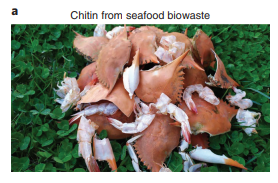Converting Biowaste into Hydroxide Exchange Membrane
Ion exchange membranes that selectively transport ions are critical for applications such as fuel cells, flow batteries, electrolyzers, and more. Compared to Nafion – a typical proton exchange membrane – hydroxide exchange membranes (HEMs), which are more compatible for use with platinum-free catalysts in alkaline electrolytes, are not well-established mainly due to the instability of HEMs in alkaline solution. Recently, a group of researchers from the Universities of Maryland (UMD) and Delaware (UD) developed a new type of copper material, Cu2+-crosslinked chitosan (chitosan-Cu), which is derived from chitin – a fibrous material primarily found in the exoskeletons of arthropods, widely available as a biowaste. Due to its unique trigonal structure, chitosan-Cu was found to be a stable, high-performance HEM. Meiling Wu, a postdoctoral associate in the UMD Department of Materials Science and Engineering (MSE), served as first author on the study published April 18 in Nature Nanotechnology. “Chitosan – a product extracted from the deacetylation of chitin – is the only basic polysaccharide that contains free amino groups, which in their cationic charged state can attract anions (e.g., OH−) for anion exchange applications, but with insufficient ion conductivity,” said Wu. “However, after combining this material with copper-ions, chitosan refreshes itself into a high-performing substance.” The copper-ion coordination process with chitosan converts the twofold symmetric structure of the chitosan chains into a unique, threefold helical arrangement. The formation of the Cu2+-crosslinked chitosan chains, in which six chains are connected by Cu2+ to form a ~1 nm wide hexagonal nanochannel, chitosan-Cu achieves fast hydroxide transport, giving way to highconductivity – the robust binding in this case is crucial for structural stability. “The features of chitosan-Cu make it an excellent ion exchange membrane for fuel cells, which we have demonstrated in a DMFC with a super-high power density,” said Liangbing Hu, MSE Professor at UMD and primary investigator on the study. “What’s more, this scalable method provides an abundant, eco-friendly and low-cost biopolymer to other HEMs currently on the market.” Wu, M. et al (2022). “A high-performance hydroxide exchange membrane enabled by Cu2+-crosslinked chitosan,” Nature Nanotechnology. DOI: 10.1038/s41565-022-01112-5
April 18, 2022 Prev Next |


